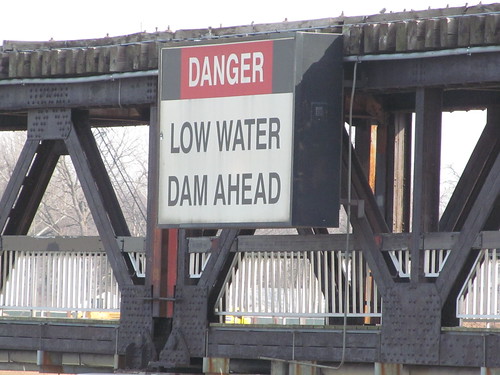Dam hazards: Ohio cities removing low-water dams
It's very typical of Tulsa to embrace an urban development fad just as other cities are rethinking and reversing course. (Case in point: No sooner did we close off Main Street for a pedestrian mall than other cities began noticing that pedestrian malls killed retail businesses and started reopening pedestrianized streets.) When officials push Tulsans to be early adopters of new fads, Tulsans say no, but officials stubbornly keep pushing, long after the moment has passed. In September 1969, Tulsans voted down a bond issue for low-water dams, 29% to 71%, but 47 years later, officials are still trying to talk us into it. Meanwhile, the rest of the world is waking up to the safety and environmental hazards posed by these decorative dams.

From the October 2015 edition of Columbus Monthly, "Low-Head Dams: Danger Below":
Though their usefulness faded decades ago, low-head dams are a lingering threat to people and wildlife. Since the 1950s, at least 441 people have died at 235 submerged dams in 38 states. About half of those deaths occurred in the past 15 years--a period in which many cities have sought to repurpose their rivers into picturesque attractions that would draw tourists and shoppers to business districts....The dams, dubbed "killer dams" and "drowning machines" by critics, can be dangerously misleading. Most onlookers observe a scenic, harmless-looking waterfall, but a submerged hydraulic jump forms deadly whirlpool-like currents....
Aside from their threat to human safety, low-head dams have been causing a deluge of ecological problems for decades, conservationists say. They stifle fish migration up and downstream, degrade the river's chemical quality, increase the water temperature and starve fish of oxygen....
As for FLOW, the group conducted water-quality studies to look at the physical, chemical and biological attributes of the Olentangy River near and around the 8-foot high concrete dam at Fifth Avenue, and found the river did not meet quality standards. FLOW, which developed the Lower Olentangy Watershed Action Plan in 2003, recommended the dam be removed. Doing so would increase dissolved oxygen levels (making it easier and better for fish to breathe), unblock sediment flow backed up by the dam and increase fish migration, they reported....
When the Fifth Avenue dam was dismantled in 2012, it joined the list of more than 50 dams removed in Ohio since 1973. In total, the project cost about $6.9 million; it took $200,000 to remove the dam. Some of the funds were allocated to create four large wetlands, establish native vegetation, and reconstruct river features and infrastructure such as storm-water outfalls. The cost was shared by Ohio EPA, Ohio State and the city....
Communities working in partnership with nonprofit organizations and state and federal agencies removed 72 dams in 19 states in 2014, according to American Rivers, a national river conservation group. Five of those removals were in Ohio, adding to the 1,185 dams removed across the U.S. since 1912.
Finding a balance between public and environmental safety can get thorny when dam owners and community members don't want their dams removed. Garcia says residents in Yorkville, Illinois, felt a strong sense of nostalgia for a 1960s-era dam on the Fox River. The dam's spillway has since been modified with four concrete steps, a fish ladder and a bypass channel for kayakers and canoeists.
"Usually the people who want the dams removed don't live near them," Garcia says. "There is almost an emotional attachment."
But Garcia says there's one driving force behind all of this: liability. Tschantz agrees, questioning the legality of having low-head dams present on waterways as a hidden and concealed danger rather than an open and obvious hazard.
0 TrackBacks
Listed below are links to blogs that reference this entry: Dam hazards: Ohio cities removing low-water dams.
TrackBack URL for this entry: https://www.batesline.com/cgi-bin/mt/mt-tb.cgi/7727